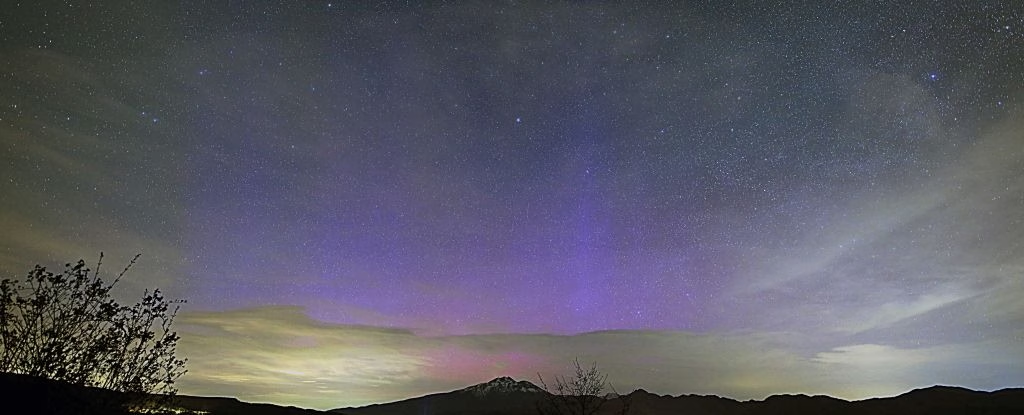Blue aurora indicates unknown atmospheric processes
- December 6, 2024
- 0
Create an image in your imagination to accompany the word “aurora borealis.” What you imagine may be dominated by the color green, intricate curls and ticks dancing in
Create an image in your imagination to accompany the word “aurora borealis.” What you imagine may be dominated by the color green, intricate curls and ticks dancing in

Create an image in your imagination to accompany the word “aurora borealis.” What you imagine may be dominated by the color green, intricate curls and ticks dancing in the sky over a frozen landscape. But the spectacular glow that appears in the sky when energetic solar particles hit atmospheric gases is not limited to the most famous manifestation. The aurora borealis can have a wide range of colors that vary depending on altitude, latitude and the gases it contains.
A strange blue glow appeared during a very powerful geomagnetic storm that shook the Earth’s magnetic cage in May 2024. Unheard of… but this was in low latitudes and reaching extremely high into the sky. Now, using images taken by citizen scientists in Japan, physicists Sota Nanyo of the Swedish Institute of Space Physics and Kazuo Shiokawa of Nagoya University have found the most likely explanation for the eerie blue light.
But their explanation creates another problem that atmospheric scientists must solve.
“Our findings suggest that molecular nitrogen ions may have been accelerated upward by some mechanism and may be responsible for the formation of the dominant blue aurora,” explains Shiokawa.
“To date, it is poorly understood how molecular nitrogen ions of large molecular weight can exist at such high altitudes. Such ions cannot easily exist for long periods of time due to their large mass and short dissociative recombination time intervals, but they are observed at very high altitudes, shrouded in mystery.”
Auroras on Earth are often the result of a coronal mass ejection, or large stream of solar particles released from the Sun during the solar wind. These particles pass through the solar system. If the Earth is on the verge of an explosion, particles will hit the magnetic field, be deflected along magnetic field lines, and be accelerated toward the poles, launching them into the atmosphere.
The interaction between solar particles and gases in the Earth’s atmosphere causes the atmospheric particles to gain some energy. When the atoms that make up the gases in the atmosphere return to their initial energy states, energy is released in the form of photons, which are the source of radiation. It is similar to the mechanism that makes fluorescent lamps glow. As with fluorescent lights, the color of the glow depends on several factors, including the type of particle and the amount of energy they gain or lose.
For example, green and red auroras are produced by oxygen atoms losing energy at different altitudes. Nitrogen atoms can emit blue and red photons. When these tones mix in the sky, yellow, purple, pink and orange colors can appear.
The aurora borealis at low latitudes is usually red. But on May 11, 2024, the sky at low latitudes lit up with a pink glow, and a distinctive blue glow appeared shortly before midnight. And we have a powerful new aurora-capturing tool: the smartphones of awestruck aurora watchers around the world.
Thanks to the large number of images and videos collected on the blue aurora, researchers were able to measure this phenomenon in detail. They found that the aurora borealis is organized into elongated structures that stretch along magnetic field lines for about 1,200 kilometers (about 750 miles). It was also organized into three separate structures and reached heights of 400 to 900 kilometers in the sky. For context, the International Space Station orbits at an altitude of 370 to 460 kilometers.
It is now believed that low-latitude aurorae are associated with the ring current. This is a torus-shaped stream of charged particles captured by Earth’s magnetosphere, which orbits the planet’s equator like a ring of floating pools. The geomagnetic storm excites energetic neutral atoms (ENAs) in the ring, causing low-latitude auroras. However, the researchers do not believe that the ring current works based on what they have observed.
“This study revealed a structure of several hundred kilometers in the aurora with a dominant blue color in the longitudinal direction, which is difficult to interpret by ENA activity alone,” says Shiokawa. “Also, ENAs are unlikely to produce aurora structures aligned with magnetic field lines, as observed in this study.”
It’s possible that the ring current plays a role, but the researchers believe something else must be involved to create the different structures that align in the field. They believe that molecular nitrogen ions are somehow accelerated upward. However, it is unknown what accelerates them. This shows that some yet unknown processes may occur in the Earth’s atmosphere. We may not currently have enough information to understand what this process is. But the answers are extremely accessible.
“As solar activity will increase in the coming decades, reanalysis of such blue-dominated auroras is expected to provide insight into the formation processes of blue-dominated aurorae at low latitudes,” the researchers write. The study was published on: Earth, Planets and Space.
Source: Port Altele
As an experienced journalist and author, Mary has been reporting on the latest news and trends for over 5 years. With a passion for uncovering the stories behind the headlines, Mary has earned a reputation as a trusted voice in the world of journalism. Her writing style is insightful, engaging and thought-provoking, as she takes a deep dive into the most pressing issues of our time.